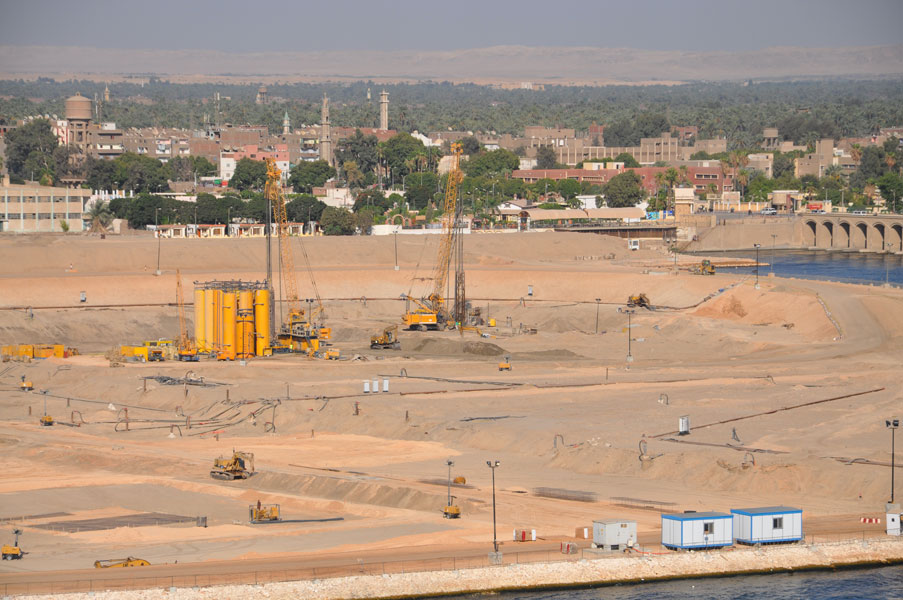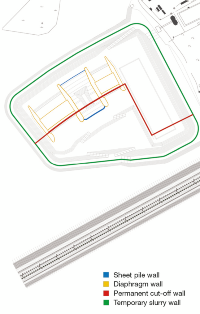New Assiut Barrage, Egypt
The Assiut Barrage is a damming structure across the river Nile in the vicinity of the city of Assiut in Upper Egypt (400 km south of Cairo). The Assiut Barrage was constructed between 1898 and 1903 across the Nile, about 560 km downstream of the Aswan Dam. Its purpose was to divert the river flow during low water levels into Egypt‘s largest irrigation canal, the Ibrahimiya Canal.
Along with the old Aswan Dam, the Assiut Barrage today remains in service as the oldest barrier on the Nile in Upper Egypt. Naga Hamadi (with the contribution of Bauer) and Isna Dams were already replaced with new dam structures in the 1990s. Between 2000 and 2005, the Egyptian government commissioned an extended feasibility studyfi nanced by the German government to investigate the options of rehabilitation or upgrade of the existing Assiut Dam and the Ibrahimiya Canal. The study evaluated the practicality of rehabilitation in comparison to a replacement with a new hydropower barrier.
German consultants financed by the Kreditanstalt für Wiederaufbau (KfW) conducted the study and concluded that a new barrier with power generating capabilities would be the most economic solution. This new retaining structure would provide an increase in the allowed pool levels, permitting more water to discharge into the Ibrahimiya Canal and improve navigation conditions. The new barrage will also include a low head hydropower plant. Based on the results of the feasibility study the decision was made to proceed with the project of constructing a new dam structure approximately 200-300 m downstream of the existing dam.
The main works for the project were awarded to the Egyptian – French New Assiut Barrage Joint Venture which consisted of the three international companies Vinci, Arab Contractor and Orascom. Due to the vast experience in both, cut-off wall construction and previous dam projects on the Nile, Bauer was awarded the sub-contract for specialist foundation engineering works, comprising of different work packages ranging from cut-off walls for temporary purposes to the construction of dewatering wells, as well as the foundation barrettes and permanent cut-off wall works.
German consultants financed by the Kreditanstalt für Wiederaufbau (KfW) conducted the study and concluded that a new barrier with power generating capabilities would be the most economic solution. This new retaining structure would provide an increase in the allowed pool levels, permitting more water to discharge into the Ibrahimiya Canal and improve navigation conditions. The new barrage will also include a low head hydropower plant. Based on the results of the feasibility study the decision was made to proceed with the project of constructing a new dam structure approximately 200-300 m downstream of the existing dam.
The main works for the project were awarded to the Egyptian – French New Assiut Barrage Joint Venture which consisted of the three international companies Vinci, Arab Contractor and Orascom. Due to the vast experience in both, cut-off wall construction and previous dam projects on the Nile, Bauer was awarded the sub-contract for specialist foundation engineering works, comprising of different work packages ranging from cut-off walls for temporary purposes to the construction of dewatering wells, as well as the foundation barrettes and permanent cut-off wall works.
The specialist foundation engineering works were designed by the German design company Lahmayer International with strong input from Bauer on the design properties of the cut-off wall and the cut-off wall material. In a first step Bauer constructed about 60,000 m² of temporary single-phase cut-off wall for the ring dam with 38.2 m in depth and 0.8 m thickness, using state-of-the-art BC 40 cutter equipment. Within the dry excavation pit of the temporary ring dam Bauer then constructed about 12,000 m² of permanent double-phase cut-off wall with varying depths between 20 and 30 m and a thickness of 0.8 m to create a cut-off under the future barrage. In addition to these cut-off wall works for the dam, Bauer also installed 18,000 m² foundation piers with 0.8 m thickness and depths up to 23 m to allow a construction of the barrage piers with low settlement.






